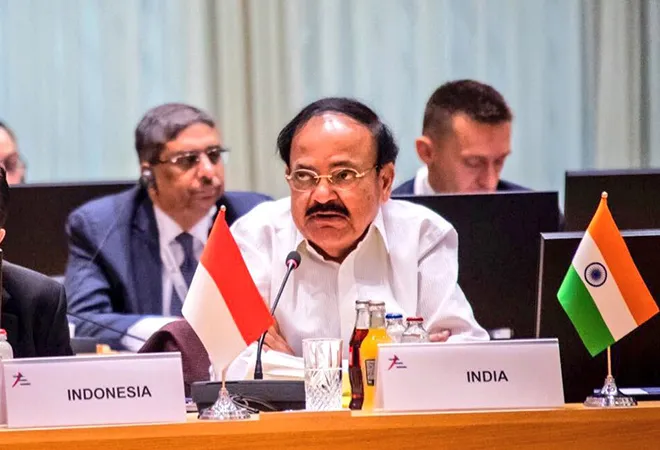-
CENTRES
Progammes & Centres
Location

On October 18th and 19th, the Hon'ble Vice President of India, Shri. M Venkaiah Naidu, attended the 12th Summit of the Asia Europe Meeting (ASEM12) in Brussels. The ASEM Summit is the highest platform for dialogue and cooperation between Asia and Europe. Dedicated to ‘Global partners for global challenges’, this summit was in line with the increasing interactions between the two continents, which are linked through a growing number of trade and cooperation agreements, as well as stronger common engagement on security cooperation.
ASEM is an intergovernmental process established in 1996 to foster dialogue and cooperation between 51 Asian and European countries plus two institutional partners (the EU and the Association of South East Asian Nations - ASEAN). India joined the forum in 2008.
ASEM aims at promoting a more global vision among European and Asian policymakers by allowing them to exchange views on political, economic, financial, social and cultural issues. ASEM also aims at stimulating a wide range of contacts and dialogue between the two regions on topics such as education, social protection and employment, and co-operation on the protection of cultural heritage.
The focus of the Summit has been stronger “Connectivity”, with discussions taking place around financial and economic issues, global issues and Europe-Asia connectivity, as well as international and regional issues. "We come out of this two-day Summit with a reinforced global partnership between Europe and Asia. It has allowed us to translate our global weight into concrete policy initiatives – on regional and international security, foreign policy issues, climate change action, free and fair trade, and the digital agenda to name a few.” said the European Union’s High Representative/Vice-President, Federica Mogherini. The aim of the Summit was indeed to promote joint actions on global challenges such as the Sustainable Development Goals, climate change, terrorism, migration, cyber security, ocean governance, education, sustainable tourism and the protection of cultural heritage. In support of those efforts, the ASEM Sustainable Connectivity Monitor (ASCM), has been presented. This tool, developed by the European Commission, measures the degree and the manner in which ASEM partners are linked via economic, physical, political, institutional and people-to-people connections.
The Summit also gave the opportunity to the European Union (EU) to present its new Strategy for Connectivity in Asia. After more than a decade working on enhancing relations with Asia, the EU proved to be finally ready to step up its engagement with Asian partners on an agenda for connectivity. Through the adoption of the EU strategy for connectivity in Asia, the EU has indeed presented its ambitions for connecting the two continents.
Acknowledging that the EU Asia relationship needs to rely on effective, functioning and sustainable connectivity, on October 15th, the EU adopted the "Connecting Europe and Asia – Building blocks for an EU strategy". This new policy framework is based on sustainable, comprehensive, and rules-based European approach, and aims at advancing investment and trade.
The new strategy comes after European Commission President Jean-Claude Juncker called for a more muscular EU foreign policy to match its economic influence, in response not only to "America First" approach of US President Donald Trump's, but also to China's energetic involvement in Africa and Asia.
Aspiring to be seen as the new alternative to the other global investors in Asia, the EU intends to contribute to improving the efficiency of cross-border connections and transport, by strengthening partnerships and by leveraging sustainable financing for investments. The EU has a strong track record of financing connectivity through combining innovative financing initiatives and creating opportunities for private sector participation. It has indeed been managing more than €8 billion of funding in Asia between 2014-2020, of which significant resources support bilateral and regional initiatives in the context of connectivity, for example ASEAN's Master Plan on Connectivity and the educational exchange programme ERASMUS+.
According to the Asia Development Bank, Asia will require over €1.3 trillion a year of infrastructure investment in the coming decades. The EU aims at supporting Asian countries meet such an investment challenge leveraging public and private financing through a combination of grants, guarantees, lending and blending. For this purpose, the Investment Facility for Central Asia, Asian Investment Facility and the European Fund for Sustainable Development (EFSD) will be called into action to catalyse additional public and private capital.
Regarding the specific attention given to India, the Connectivity Strategy will build on the achievement of student exchanges and staff mobility. Since 2004, when India and the EU signed a strategic partnership, more than 5,300 Indian students received Erasmus Scholarships to study in EU countries’ universities and 1,800 Indian researches have been granted Marie Skłodowska Curie Scholarship to carry on research projects in the EU. In addition to these efforts aiming at building connections and mutual understanding, support will be given on the construction of electricity transmission system, infrastructure data transfers and community integration.
“We want to give our relationship with Asia, fresh impetus” said President Jean- Claude Juncker.
Relations between the EU and Asia are indeed moving forward. Together, Europe and Asia account for almost 70 percent of global population and over 60 percent of the world's GDP. Thanks to the new Connectivity Strategy aimed at stepping up EU actions in Asia, EU is now posing as a valid alternative to Chinese investments in infrastructures. It is now time to leave to implementation and to concrete actions to prove that the EU is capable of backing its intentions with actions.
The views expressed above belong to the author(s). ORF research and analyses now available on Telegram! Click here to access our curated content — blogs, longforms and interviews.

Stefania Benaglia is Research Associate at the Italian Istituto Affari Internazionali (IAI). Her research focus is on EU-India relations South Asia EU foreign and security ...
Read More +